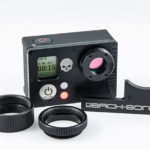
Luc Besson Shoots His First Digital Movie
Posted on Aug 6, 2014 by Alex Fice
Luc Besson’s ‘Lucy’ opens today and is the director’s first all digital movie.
Lucy the latest film by Luc Besson, featuring Scarlett Johansson and Morgan Freeman, is released today. Thierry Arbogast AFC and DoP on this film and on many of Besson’s other films including Fifth Element shares his experience of shooting with the Sony F65 camera as well as the Arri Alexa XT and The RED Epic.
What made you choose the F65?
“Until now, Luc has filmed very little in digital — just a few shots here and there for technical reasons and never a whole film. For Lucy, he wanted to take the plunge. We therefore began comparative tests on the three cameras of the moment, namely the RED Epic, the Arri Alexa and the Sony F65.
“After the test projections, we all agreed that the F65 was visually superior to the other two cameras. Of course during grading we always end up combining the three cameras, but the natural image of the F65 won us all over.
“During the projection, it was Luc who spoke first. There was no doubt that for him, it was the F65 that stood out from the others. A huge draw for him was the colour fidelity and rendition of skin tones. The colours were really there; we could pick out the blue of the jumper and the carnations seemed very natural.
“But we actually filmed with all three cameras for different reasons, above all due to space requirements.”
 The director likes to operate the camera on his own films – pictured with the Sony F65 camera. Photo by Jessica Forde © Universal Pictures
The director likes to operate the camera on his own films – pictured with the Sony F65 camera. Photo by Jessica Forde © Universal Pictures
At what sensitivity did you use the F65?
“I worked at the nominal sensitivity of the camera, that is to say 800 ISO. We conducted the tests in Pigalle, at night, with all three cameras. And I found that the sensitivity of the F65 and the Alexa were very similar, while the sensitivity of the Epic was much lower.”
How did you expose the F65?
“As a general rule, the digital imaging technician or the DIT controls the iris with a remote control. Before the shot, we discuss the desired effect and jointly agree on the best exposure. For example, I tell him if I want to leave the shutters to explode or not, the black level and where the key light is, among other things.
“After, if iris changes are needed during the take, he will take care of them by keeping an eye on the curve of the monitor.”
Did you film in 8K?
“No, we worked in 4K. We were aware that we had a racing car, but we didn’t want to step too hard on the accelerator! For this film, 8K was not needed, especially as the film will be released in 2K in most cinemas.
“Of course, there are exclusive showings planned in 4K, but the release prints will be in 2K. The special effects department was very pleased with the 4K files we provided. I think 8K would have significantly increased their computing time.
“8K is obviously a good thing in itself because, as we always say, it’s better to start too high and come back down and of course we would have been able to get a better 4K file from an 8K file. From the preparation stage of the film, I insisted that Luc film in 4K. At that time, the first 4K screens and televisions were starting to appear. Dynamic 4K is already here, perhaps more in the United States than in France, but it’s started.”
How do you feel about the ergonomics?
“Luc is always the one who frames his films. He could tell you better than I could. But just like the Panavision Genesis or the Sony F35, we are not talking about cameras that are very attractive from an ergonomic point of view. We would have preferred a camera that was more compact. However, its design makes the F65 much more balanced on the shoulder than a RED. For some shots that we wanted to film with a Movi so we called on the Epic for that.
“It’s a camera that is surprising, above all because of its lightness. Despite its rounded shapes and impressive appearance, it is still a fairly lightweight camera, and I presume that this is thanks to the materials that it’s made from. In my opinion, its weight is virtually identical to that of an Alexa, although their volume is obviously very different.”
What was the grading process like?
“It must be said that we were dealing with three great cameras and everything went very well. In addition, when you are working with a good grader, you always manage to erase all the differences between them.
“Even though their debayering system is not the same and despite all the other differences, we had no problems harmonising them.
“If we wanted to summarise their respective benefits, we could say that the Alexa has the best dynamic range, the F65 offers the best colour rendition and the Epic is the lightest.” (There is less than a Kg’s difference between the weight of these two cameras – 13.5 kg for the F65 and 12.6 kg for the Alexa, both equipped with two RAW recording modules).
Did you use the built-in neutral density filters?
“Yes, were found them very useful. They are extremely quick to use and they eliminate a glass surface in front of the lens. Every now and then we were just a bit sorry that they started at ND0.9. We would sometimes have liked an ND0.6 or an ND0.3. But Sony’s choice is understandable because high-density neutral filters are mainly used only when there are major changes in light.”
 The movie was shot with the Sony f65, Arri’s Alexa XT and the RED Epic.
The movie was shot with the Sony f65, Arri’s Alexa XT and the RED Epic.
Did you film at 120 fps?
“We had very few high-speed shots, just a few for special effects. We took crowd shots at 100 fps and at very fast shutter speeds of up to 45 degrees to avoid panning issues. Here the camera’s sensitivity helped me a lot. The sequence was shot in a studio, where we recreated daylight. I had a 24 kW HMI for the sun and two 18 kW HMIs in the background to cover a 250m2 set, and I was at full aperture. I would never have been able to do that with a less-sensitive camera.”
What lenses did you use? And did you feel the need to filter?
“As a general rule, Luc never filters with diffusers. He likes a sharp image, without a diffusion filter. I therefore tried to choose lenses that were not too hard, like Cooke S4s for example, which are quite soft, round and flexible. They are not at all aggressive.
“As Luc loves zooming, we also had a zoom lens, a Fujinon ALURA 18–80 mm, which is a really effective lens. The advantage of the zoom lens is that when you tighten it to 80mm, the image is a little softer than with an 80mm fixed-focus lens.
“Most of the time, I prefer to work on soft media. For the camera, I prefer the softness of RAW to the hardness of a compressed file because this softness enables us to find information.”
Do you have any criticisms of this camera or is there anything you would like to see?
“I’m really looking forward to a digital camera that is capable of ramping, you know — the idea of changing pace when shooting while simultaneously compensating for exposure using the shutter. For this film, we planned on doing that but the F65 didn’t allow it.
“I also like the idea of upgradeable cameras, such as the EPIC, which has become the DRAGON. Today, camera components are mainly electronic and the evolution in this area is permanent. In this sense, it would be good to offer the possibility of changing these components, while keeping the packaging!
“The only thing that I would criticise about this camera is the size of its sensor because I prefer large sensors. The bigger it is, the better! The F65 is equipped with a Super 35-mm sensor (24.7 mm x 13.1 mm). I would have preferred a 4:3 sensor, or even a 24 x 26 mm. I am therefore eagerly awaiting Sony’s “70 mm” camera!
Interview by Pierre Souchar
BBC TV Interview link with Luc Besson
Full camera spec for Lucy was:
Arri Alexa XT Plus, Cooke S4 and Fujinon Alura Lenses.
Red Epic, Cooke S4 and Fujinon Alura Lenses.
Sony CineAlta F65, Cooke S4 and Fujinon Alura Lenses.








